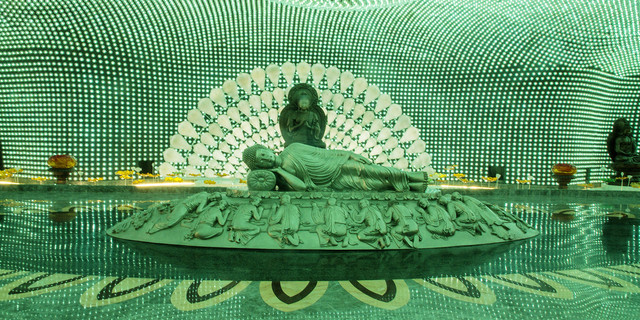24 Hours Hotline: +86 137-3541-1378
Email:suzhou@tripstoshanghai.com
24 Hours Hotline: +86 137-3541-1378
Email:suzhou@tripstoshanghai.com

Dacheng Temple, Nanjing
Overview
The Temple of Confucius in Qufu, Shandong Province, is the largest and most renowned temple of Confucius in East Asia.
Since 1994, the Temple of Confucius has been part of the UNESCO World Heritage Site "Temple and Cemetery of Confucius and the Kong Family Mansion in Qufu". The two other parts of the site are the nearby Kong Family Mansion, where the main-line descendants of Confucius lived, and the Cemetery of Confucius a few kilometers to the north, where Confucius and many of his descendants have been buried. Those three sites are collectively known in Qufu as San Kong, i.e. "The Three Confucian".
History & Background
Within two years after the death of Confucius, his former house in Qufu was already consecrated as a temple by the Prince of Lu. In 205 BC, Emperor Gao of the Han Dynasty was the first emperor to offer sacrifices to the memory of Confucius in Qufu. He set an example for many emperors and high officials to follow. Later, emperors would visit Qufu after their enthronement or on important occasions such as a successful war. In total, 12 different emperors paid 20 personal visits to Qufu to worship Confucius. About 100 others sent their deputies for 196 official visits. The original three-room house of Confucius was removed from the temple complex during a rebuilding undertaken in 611 AD. In 1012 and in 1094, during the Song Dynasty, the temple was extended into a design with three sections and four courtyards, around which eventually more than 400 rooms were arranged. Fire and vandalism destroyed the temple in 1214, during the Jin Dynasty. It was restored to its former extent by the year 1302 during the Yuan Dynasty. Shortly thereafter, in 1331, the temple was framed in an enclosure wall modelled on the Imperial palace.
After another devastation by fire in 1499, the temple was finally restored to its present scale. In 1724, yet another fire largely destroyed the main hall and the sculptures it contained. The subsequent restoration was completed in 1730. Many of the replacement sculptures were damaged and destroyed during the Cultural Revolution in 1966. In total, the Temple of Confucius has undergone 15 major renovations, 31 large repairs, and numerous small building measures.
Another main Confucius Temple was built in Quzhou by the southern branch of the Confucius family.
Layout & Function
The temple complex is among the largest in China, it covers an area of 16,000 square metres and has a total of 460 rooms. Because the last major redesign following the fire in 1499 took place shortly after the building of the Forbidden City in the Ming Dynasty, the architecture of the Temple of Confucius resembles that of the Forbidden City in many ways.
The main part of the temple consists of 9 courtyards arranged on a central axis, which is oriented in the north-south direction and is 1.3 km in length. The first three courtyards have small gates and are planted with tall pine trees, they serve an introductory function. The first (southernmost) gate is named "Lingxing Gate" after a star in the Great Bear constellation, the name suggests that Confucius is a star from heaven. The buildings in the remaining courtyards form the heart of the complex. They are impressive structures with yellow roof-tiles (otherwise reserved for the emperor) and red-painted walls, they are surrounded by dark-green pine trees to create a color contrast with complementary colors.
The main structures of the temple are:
Lingxing Gate (???)
Shengshi Gate (???)
Hongdao Gate (???)
Dazhong Gate (???)
Thirteen Stele Pavilions (????)
Dacheng Gate (???)
Kuiwen Hall (???, built in 1018, restored in 1504 during the Ming Dynasty and in 1985)
Xing Tan Pavilion (??, Apricot Platform)
De Mu Tian Di Arch
Liangwu (??)
Dacheng Hall (???, built in the Qing Dynasty)
Resting Hall (??, dedicated to Confucius' Wife)
Dacheng Hall
The Dacheng Hall, whose name is usually translated as the Hall of Great Perfection or the Hall of Great Achievement, is the architectural center of the present-day complex. The hall covers an area of 54 by 34 m and stands slightly less than 32 m tall. It is supported by 28 richly decorated pillars, each 6 m high and 0.8 m in diameter and carved in one piece out of local rock. The 10 columns on the front side of the hall are decorated with coiled dragons. It is said that these columns were covered during visits by the emperor in order not to arouse his envy. Dacheng Hall served as the principal place for offering sacrifices to the memory of Confucius. It is also said to be one of the most beautiful views of Confucius Temple.
Apricot Platform
In the center of the courtyard in front of Dacheng Hall stands the Xing Tan Pavilion, or the Apricot Platform. It commemorates Confucius teaching his students under an apricot tree. Each year at Qufu and at many other Confucian temples a ceremony is held on September 28 to commemorate Confucius' birthday.
Duration:6-8 Hours
Attractions(Cities):Nanjing Massacre Museum, Presidential Palace, Yuejianglou Tower, Confucius Temple
Tour Style:This one-day Nanjing private tour offers a perfect blend of history, culture, and scenic beauty. Your day begins at Sun Yat-Sen’s Mausoleum, nestled against the stunning backdrop of Purple Mountain, where you’ll learn about the legacy of modern China’s founding father. Next, visit the Ming Xiaoling Mausoleum, the burial site of the first Ming emperor, famous for its grand architecture and tranquil surroundings. In the afternoon, head to the Confucius Temple, a serene cultural site set along the lively Qinhuai River, where you can immerse yourself in both the spiritual significance and local charm of Nanjing’s historic heart. Finally, explore the Nanjing Ming City Wall, a well-preserved fortress offering panoramic views of the city. This thoughtfully crafted itinerary offers a comprehensive look at Nanjing’s iconic landmarks, combining rich history with scenic landscapes for an enriching and memorable experience.
Duration:10+ Hours
Attractions(Cities):Sun Yet-Sen Mausoleum, Ming Xiaoling Mausoleum, Zhonghua Gate, Confucius Temple
Tour Style:This Nanjing Day Tour from Shanghai offers a deep dive into the history and culture of the Ming Dynasty. Visit must-see landmarks such as the ancient City Wall, the impressive Ming Xiaoling Mausoleum, the formidable Zhonghua Gate, the vast Nanjing Museum, and the serene Confucius Temple. Each site offers unique insights into Nanjing’s rich historical and cultural heritage. With personalized service and expert guidance, this tour ensures a seamless and enriching experience, allowing you to explore Nanjing’s rich heritage at your own pace while learning about the city’s pivotal role in Chinese history. Enjoy comfortable transportation and ample time to absorb the beauty and significance of each landmark, making for a memorable and immersive day in one of China’s most historic cities. This expertly designed itinerary combines cultural immersion, historical exploration, and local flavor, ensuring a comprehensive and fulfilling experience for every traveler.
Duration:6-8 Hours
Attractions(Cities):Linggu Temple, Qixia Temple, Jiming Temple
Tour Style:This Nanjing 1 day tour is thoughtfully crafted for travelers seeking a deep, soulful experience that blends Buddhist spirituality with the tranquility of nature. Ideal for those interested in cultural immersion, spiritual reflection, and scenic beauty, the tour brings you to Nanjing’s most revered temples—Linggu Temple, Qixia Temple, and Jiming Temple—each with its own unique atmosphere and historical legacy. Gentle forest walks on Purple Mountain and around Qixia Valley provide moments of serenity and scenic wonder, while a wholesome vegetarian lunch adds a mindful, nourishing touch to your journey. Led by an insightful English-speaking guide, this tour offers not only historical knowledge, but also emotional connection and cultural depth. Whether you’re a solo traveler, a couple, or a group of spiritually curious explorers, this full-day escape promises peace, inspiration, and a deeper understanding of Chinese Buddhism and nature-based philosophy.
Duration:6-8 hours
Attractions(Cities):Niushoushan, Zhonghuamen Gate, The Confucius Temple
Tour Style:This private Nanjing day tour blends spiritual discovery with historical exploration, offering a balanced journey through the tranquil Buddhist temples of Niushoushan, the formidable Ming-era architecture of Zhonghua Gate, and the vibrant cultural atmosphere of Confucius Temple. At Niushoushan, you’ll uncover the deep-rooted Buddhist traditions and admire the magnificent Usnisa Palace, a masterpiece of religious architecture. Then, step back in time at Zhonghua Gate, the largest surviving ancient city gate complex in China, where military strategy and craftsmanship meet. Finally, soak in the lively charm of the Confucius Temple area, with its riverside views, traditional streets, and enduring legacy of Confucian thought. Ideal for travelers seeking cultural depth, peaceful scenery, and architectural wonders, this one-day experience combines sacred spaces, ancient city walls, and historic ambiance—all with the comfort of a personal guide, private vehicle, and local insights that bring Nanjing's rich heritage to life.
Duration:6-8 Hours
Attractions(Cities):Sun Yet-Sen Mausoleum, Presidential Palace, Lingu Temple, Confucious Temple
Tour Style:Make the most of your time to get a unique travel experience in Nanjing on a full-day Nanjing tour. Served as the capital city of ancient China, Nanjing is endowed with profound history and cultural sites. With your knowledgeable and historical guide, you'll visit the majestic Sun Yat-Sen Mausoleum, marvel at the Presidential Palace, explore the peaceful Lingu Temple, and follow in the paths of emperors on a relaxing Qinhuai River cruise near the Confucius Temple. This tour combines rich history, stunning architecture, and beautiful natural surroundings, offering you an immersive experience of Nanjing's culture and heritage. It is a perfect private-designed tour to lead you through Nanjing's timeless landmarks with comfortable city transfer, ensuring a smooth and unforgettable journey.
Wechat: Chinaprivatetour
24 Hours Hotline:
+86 137-3541-1378
(Your Privacy is Protected)
1 to 1 tailor-made service from our professional travel advisors for the most sophisticated
Constantly excellent reviews for attraction, hotel and service Competitive price
Local experts provide quality tours Best selected knowledgeable local guides Authentic local restaurants
7*24 hours available to create you a worry-free tour. No Hidden Fees and absolutely no pressure to buy. Secured









Copyright © 2017 Suzhouprivatetour.com All rights reserved. 浙ICP备18056007号-4